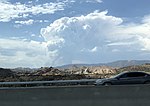Three Points, California
1892 establishments in CaliforniaPopulated places established in 1892Sierra Pelona RidgeUnincorporated communities in CaliforniaUnincorporated communities in Los Angeles County, California ... and 1 more
Use mdy dates from July 2023

Three Points is a scenic, sparsely populated unincorporated community at the northwestern edge of Los Angeles County, in the northern Sierra Pelona Mountains foothills and southwest of the Antelope Valley in Southern California, United States.
Excerpt from the Wikipedia article Three Points, California (License: CC BY-SA 3.0, Authors, Images).Three Points, California
Pine Canyon Road,
Geographical coordinates (GPS) Address Nearby Places Show on map
Geographical coordinates (GPS)
| Latitude | Longitude |
|---|---|
| N 34.7358155 ° | E -118.5986976 ° |
Address
Pine Canyon Road 26483
93532
California, United States
Open on Google Maps





